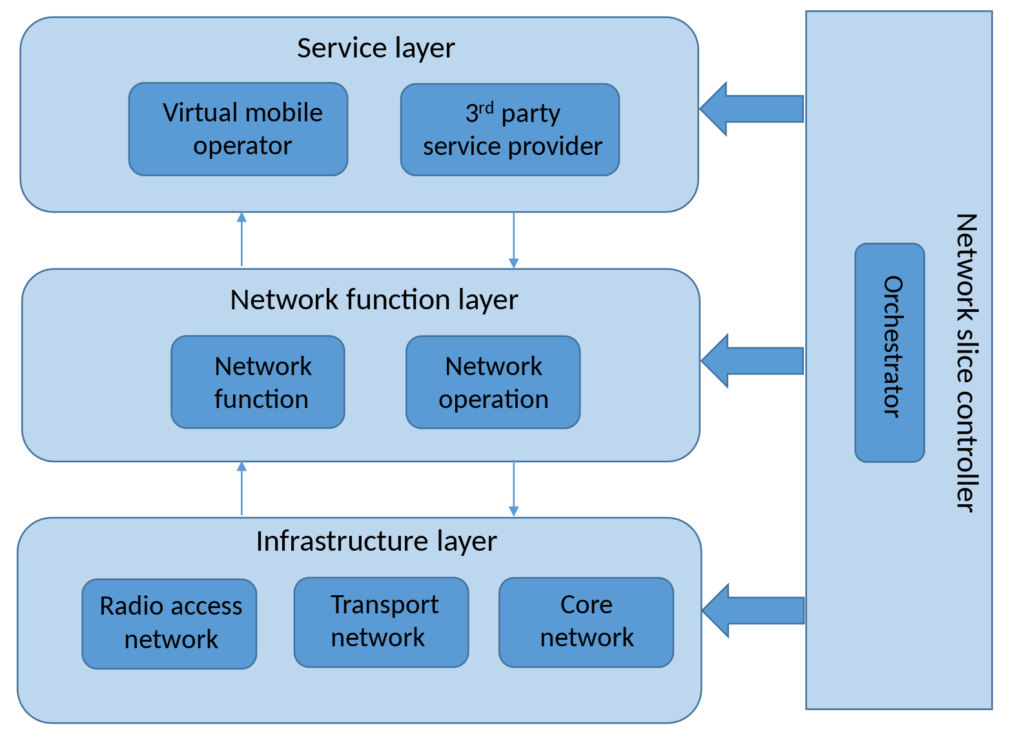Network slicing technology has been actively helping the telecommunication and wireless networking community for years. As the name suggests, the technology helps network providers slice a single network into multiple virtual networks built on a single infrastructure setup. Network slicing overlays these multiple virtual networks on top of a shared network. Moreover, through network slicing, each of the sliced virtual networks can be configured separately with different network attributes such as logical topology, security rules, and performance characteristics to cater to different use-cases. However, each of these sliced virtual networks is bound by the limitations of the underlying hardware setup. The next step in this technology: 5G network slicing
Basics of network slicing
Network slicing is not a new concept and dates back to initial implementations of virtual local area networks (VLANs). However, we started to witness its full potential after the wide-spread implementations of software-defined networks and software-defined wide-area networks (SD-WANs). By definition, network slicing defines multiple virtual network slices originated or built on a single physical network infrastructure. Each network slice represents an independent virtual instance defined by allocating a subset of the available network resources. Usually, each of these network slices is meant to provide tailored requirements for any networking application or service.

Network slicing provides several benefits
- Better customer experience as these network slices can be tailor-made for different customers’ needs.
- It allows flexibility and agility in terms of building network applications.
- Optimal use of resources and simple resource management paradigm.
- Reduced risks.
- Separation of concerns.
- Increased scope of automation.
- Better control and ease of reconfiguration when needed.
5G network slicing
While the mobile operators and network providers are still scrambling over improving the efficiency of 5G network provisions, one of the vital aspects to serve the wide range of applications and demands of 5G networks is the use of network slicing. 5G network slicing is essentially using the network virtualization technology mentioned above to divide a single network into multiple distinct network slices capable of providing different resources based on the type of traffic.
5G network slicing will allow the network vendors and operators to use a portion of the 5G network spectrum to split and serve various use-cases, including mobile networking, smart homes, IoT, and smart entry grids. Having a distinction in these use-cases can allow the telecom operator to optimize the underlying hardware resources and network topology to meet the standards in terms of latency, SLAs, connectivity, speed, and capacity.

5G network spectrum is a costly and finite commodity. While most telecom operators are planning to switch to complete 5G network support, everyone is struggling with scalability-related concerns of the network spectrum. Employing network slicing technology can enable vendors to efficiently maximize the network spectrum and resources to serve the upscaling peak demand for the network. Network slicing also allows resources and network provision, reconfiguration, and monitoring on the go making it an efficient solution to meet the growing 5G network demand worldwide.
Use-cases of 5G network slicing
Here are the common use-cases of the 5G network slicing, which serves almost all the common applications of the 5G network spectrum.
Performance
5G network slicing supports enhanced mobile broadband (eMBB), which aims at maximizing the network speeds and data rates while having an acceptable QoS, including reliability and packet-error rates.
5G network slicing can also enable network providers to serve various clients by providing a tailor-made network for maximum performance. For instance, a 5G network provider can use network slicing techniques to provide a minimal latency slice to time-sensitive applications such as autonomous vehicle management, which typically require latency under 5 milliseconds.
Capacity
Several other applications, such as surveillance and security systems, need very high network bandwidths, capacity, reliability, and quality of service support. The throughput from surveillance cameras can constantly be over 1.5 megabytes per second without any packet drops. Network providers can aggregate multiple processing devices and connectivity to meet the needs of these types of use-cases through slicing.
Industrial application and IoT can require massive machine-to-machine connections that need multiple connections with varying latency and bandwidth. All these growing needs can be addressed using network slicing as it allows both upscaling and downscaling of the network resources on the 5G network spectrum.
Security and identity management
Cybersecurity is now an absolute priority for all organizations and the 5G network has been built with security as a priority. Therefore, all firms require a highly secure and reliable network spectrum to minimize the risks associated with network security breaches such as data sniffing, ransomware, and data leaks, among others.

5G network slicing can also help vertical industries provide various levels of security and identity management. It can also cater to the growing device-user identity management and related lifecycle management.
Application-specific slicing
5G networks can be sliced to serve various use-cases, including fueling the mobile broadband slice that focuses on communication, entertainment, and the Internet. It can also be applied in the IoT sector to serve retail, manufacturing, industrial, shipping, and mission-critical IoT applications such as medical and infrastructure industries, among several others.
Apart from these use-cases and applications, 5G network slicing also has the potential to fuel up several businesses and enterprise possibilities.
Network technologies: From evolution to revolution
Mobile communications are constantly changing, and ever since the first-generation network, we have witnessed an exponential change in the network infrastructures, their behavior, and capabilities. From supporting only calls over the network to supporting high-speed super-reliable network connections alongside the trivial calling options, network technologies have undergone a long evolution. With 5G fueling the new possibilities from network technologies, network slicing can play a crucial role in supplementing the growing demand and usage.
Featured image: Shutterstock



